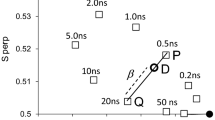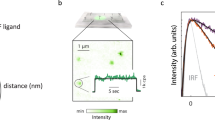Abstract
The activation of human epidermal growth factor receptor (hEGFR) involves a large conformational change in its soluble extracellular domains (sECD, residues 1–620), from a tethered to an extended conformation upon binding of ligands, such as EGF. It has been reported that this dynamic process is pH-dependent, that is, hEGFR can be activated by EGF at high pH to form an extended dimer but remains as an inactive monomer at low pH. In this paper, we perform all-atom molecular dynamics (MD) simulations starting from the tethered conformation of sECD:EGF complex, at pH 5.0 and 8.5, respectively. Simulation results indicate that sECD:EGF shows different dynamic properties between the two pHs, and the complex may have a higher tendency of activation at pH 8.5. Twenty residues, including 13 histidines, in sECD:EGF have different protonation states between the two pHs (calculated by the H++ server). The charge distribution at pH 8.5 is more favorable for forming an extended conformation toward the active state of sECD than that at pH 5.0. Our study may shed light on the mechanism of pH dependence of hEGFR activation.

pH dependence of ligand-induced human epidermal growth factor receptor activation






Similar content being viewed by others
References
Ferguson KM (2008) Structure-based view of epidermal growth factor receptor regulation. Annu Rev Biophys 37:353–373. doi:10.1146/annurev.biophys.37.032807.125829
Yarden Y, Sliwkowski MX (2001) Untangling the ErbB signalling network. Nat Rev Mol Cell Biol 2(2):127–137. doi:10.1038/35052073
Harris RC, Chung E, Coffey RJ (2003) EGF receptor ligands. Exp Cell Res 284(1):2–13. doi:10.1016/s0014-4827(02)00105-2
Citri A, Yarden Y (2006) EGF-ERBB signalling: towards the systems level. Nat Rev Mol Cell Biol 7(7):505–516. doi:10.1038/nrm1962
Riese DJ 2nd, Gallo RM, Settleman J (2007) Mutational activation of ErbB family receptor tyrosine kinases: insights into mechanisms of signal transduction and tumorigenesis. Bioessays 29(6):558–565. doi:10.1002/bies.20582
Nicholson RI, Gee JM, Harper ME (2001) EGFR and cancer prognosis. Eur J Cancer 37(Suppl 4):S9–S15
Yarden Y (2001) The EGFR family and its ligands in human cancer: signalling mechanisms and therapeutic opportunities. Eur J Cancer 37(Suppl 4):S3–S8
Wujcik D (2006) EGFR as a target: rationale for therapy. Semin Oncol Nurs 22(1 Suppl 1):5–9. doi:10.1016/j.soncn.2006.01.010
Grandal MV, Madshus IH (2008) Epidermal growth factor receptor and cancer: control of oncogenic signalling by endocytosis. J Cell Mol Med 12(5A):1527–1534. doi:10.1111/j.1582-4934.2008.00298.x
Ullrich A, Coussens L, Hayflick JS, Dull TJ, Gray A, Tam AW, Lee J, Yarden Y, Libermann TA, Schlessinger J et al (1984) Human epidermal growth factor receptor cDNA sequence and aberrant expression of the amplified gene in A431 epidermoid carcinoma cells. Nature 309(5967):418–425. doi:10.1038/309418a0
Bajaj M, Waterfield MD, Schlessinger J, Taylor WR, Blundell T (1987) On the tertiary structure of the extracellular domains of the epidermal growth factor and insulin receptors. Biochim Biophys Acta 916(2):220–226. doi:10.1016/0167-4838(87)90112-9
Ward CW, Hoyne PA, Flegg RH (1995) Insulin and epidermal growth factor receptors contain the cysteine repeat motif found in the tumor necrosis factor receptor. Proteins 22(2):141–153. doi:10.1002/prot.340220207
Garrett TP, McKern NM, Lou M, Elleman TC, Adams TE, Lovrecz GO, Zhu HJ, Walker F, Frenkel MJ, Hoyne PA, Jorissen RN, Nice EC, Burgess AW, Ward CW (2002) Crystal structure of a truncated epidermal growth factor receptor extracellular domain bound to transforming growth factor alpha. Cell 110(6):763–773
Ogiso H, Ishitani R, Nureki O, Fukai S, Yamanaka M, Kim JH, Saito K, Sakamoto A, Inoue M, Shirouzu M, Yokoyama S (2002) Crystal structure of the complex of human epidermal growth factor and receptor extracellular domains. Cell 110(6):775–787
Lu C, Mi LZ, Grey MJ, Zhu J, Graef E, Yokoyama S, Springer TA (2010) Structural evidence for loose linkage between ligand binding and kinase activation in the epidermal growth factor receptor. Mol Cell Biol 30(22):5432–5443. doi:10.1128/MCB.00742-10
Ferguson KM, Berger MB, Mendrola JM, Cho HS, Leahy DJ, Lemmon MA (2003) EGF activates its receptor by removing interactions that autoinhibit ectodomain dimerization. Mol Cell 11(2):507–517. doi:10.1016/S1097-2765(03)00047-9
Karplus M, McCammon JA (2002) Molecular dynamics simulations of biomolecules. Nat Struct Biol 9:646–652
Adcock SA, McCammon JA (2006) Molecular dynamics: survey of methods for simulating the activity of proteins. Chem Rev 106(5):1589–1615
Dror RO, Dirks RM, Grossman JP, Xu H, Shaw DE (2012) Biomolecular simulation: a computational microscope for molecular biology. Annu Rev Biophys 41:429–452. doi:10.1146/annurev-biophys-042910-155245
Kastner J, Loeffler HH, Roberts SK, Martin-Fernandez ML, Winn MD (2009) Ectodomain orientation, conformational plasticity and oligomerization of ErbB1 receptors investigated by molecular dynamics. J Struct Biol 167(2):117–128. doi:10.1016/j.jsb.2009.04.007
Tynan CJ, Roberts SK, Rolfe DJ, Clarke DT, Loeffler HH, Kastner J, Winn MD, Parker PJ, Martin-Fernandez ML (2011) Human Epidermal Growth Factor Receptor (EGFR) aligned on the plasma membrane adopts key features of drosophila EGFR asymmetry. Mol Cell Biol 31(11):2241–2252. doi:10.1128/MCB.01431-10
Zhang Z, Wriggers W (2011) Polymorphism of the epidermal growth factor receptor extracellular ligand binding domain: the dimer interface depends on domain stabilization. Biochemistry 50(12):2144–2156. doi:10.1021/bi101843s
Arkhipov A, Shan Y, Das R, Endres NF, Eastwood MP, Wemmer DE, Kuriyan J, Shaw DE (2013) Architecture and membrane interactions of the EGF receptor. Cell 152(3):557–569. doi:10.1016/j.cell.2012.12.030
Arkhipov A, Shan Y, Kim ET, Dror RO, Shaw DE (2013) Her2 activation mechanism reflects evolutionary preservation of asymmetric ectodomain dimers in the human EGFR family. Elife 2:e00708. doi:10.7554/eLife.00708
Loeffler HH, Winn MD (2013) Ligand binding and dynamics of the monomeric epidermal growth factor receptor ectodomain. Proteins 81(11):1931–1943. doi:10.1002/prot.24339
Perilla JR, Leahy DJ, Woolf TB (2013) Molecular dynamics simulations of transitions for ECD epidermal growth factor receptors show key differences between human and drosophila forms of the receptors. Proteins 81(7):1113–1126. doi:10.1002/prot.24257
Poger D, Mark AE (2014) Activation of the epidermal growth factor receptor: a series of twists and turns. Biochemistry 53(16):2710–2721. doi:10.1021/bi401632z
Webb B, Sali A (2014) Protein structure modeling with MODELLER. Methods Mol Biol 1137:1–15. doi:10.1007/978-1-4939-0366-5_1
Anandakrishnan R, Aguilar B, Onufriev AV (2012) H++ 3.0: automating pK prediction and the preparation of biomolecular structures for atomistic molecular modeling and simulations. Nucleic Acids Res 40(Web Server issue):W537–W541. doi:10.1093/nar/gks375
Bashford D, Karplus M (1990) pKa’s of ionizable groups in proteins: atomic detail from a continuum electrostatic model. Biochemistry 29(44):10219–10225. doi:10.1021/bi00496a010
Li H, Robertson AD, Jensen JH (2005) Very fast empirical prediction and rationalization of protein pKa values. Proteins 61(4):704–721. doi:10.1002/prot.20660
Dolinsky TJ, Nielsen JE, McCammon JA, Baker NA (2004) PDB2PQR: an automated pipeline for the setup of poisson-boltzmann electrostatics calculations. Nucleic Acids Res 32:W665–W667. doi:10.1093/nar/gkh381
Hess B, Kutzner C, van der Spoel D, Lindahl E (2008) GROMACS 4: algorithms for highly efficient, load-balanced, and scalable molecular simulation. J Chem Theory Comput 4(3):435–447. doi:10.1021/Ct700301q
Yong D, Chun W, Chowdhury S, Lee MC, Guoming X, Wei Z, Rong Y, Cieplak P, Ray L, Taisung L, Caldwell J, Junmei W, Kollmann P (2003) A point-charge force field for molecular mechanics simulations of proteins based on condensed-phase quantum mechanical calculations. J Comput Chem 24(16):1999–2012. doi:10.1002/jcc.10349
Jorgensen WL, Chandrasekhar J, Madura JD, Impey RW, Klein ML (1983) Comparison of simple potential functions for simulating liquid water. J Chem Phys 79(2):926–935. doi:10.1063/1.445869
Hockney RW, Goel SP, Eastwood JW (1974) Quiet high-resolution computer models of a plasma. J Comput Phys 14(2):148–158. doi:10.1016/0021-9991(74)90010-2
Bussi G, Donadio D, Parrinello M (2007) Canonical sampling through velocity rescaling. J Chem Phys 126(1):014101. doi:10.1063/1.2408420
Berendsen HJC, Postma JPM, Vangunsteren WF, Dinola A, Haak JR (1984) Molecular-dynamics with coupling to an external bath. J Chem Phys 81(8):3684–3690. doi:10.1063/1.448118
Hess B (2008) P-LINCS: a parallel linear constraint solver for molecular simulation. J Chem Theory Comput 4(1):116–122. doi:10.1021/Ct700200b
Essmann U, Perera L, Berkowitz ML, Darden T, Lee H, Pedersen LG (1995) A smooth particle mesh Ewald method. J Chem Phys 103(19):8577–8593. doi:10.1063/1.470117
Amadei A, Linnsen ABM, Berendsen HJC (1993) Essential dynamics of proteins. Proteins 17:412–425
Kollman PA, Massova I, Reyes C, Kuhn B, Huo SH, Chong L, Lee M, Lee T, Duan Y, Wang W, Donini O, Cieplak P, Srinivasan J, Case DA, Cheatham TE (2000) Calculating structures and free energies of complex molecules: combining molecular mechanics and continuum models. Acc Chem Res 33(12):889–897. doi:10.1021/ar000033j
Onufriev A, Bashford D, Case DA (2004) Exploring protein native states and large-scale conformational changes with a modified generalized born model. Proteins 55(2):383–394. doi:10.1002/prot.20033
Andricioaei I, Karplus M (2001) On the calculation of entropy from covariance matrices of the atomic fluctuations. J Chem Phys 115(14):6289–6292. doi:10.1063/1.1401821
Balsera MA, Wriggers W, Oono Y, Schulten K (1996) Principal component analysis and long time protein dynamics. J Phys Chem 100(7):2567–2572. doi:10.1021/jp9536920
Dolinsky TJ, Czodrowski P, Li H, Nielsen JE, Jensen JH, Klebe G, Baker NA (2007) PDB2PQR: expanding and upgrading automated preparation of biomolecular structures for molecular simulations. Nucleic Acids Res 35(Web Server issue):W522–W525. doi:10.1093/nar/gkm276
Baker NA, Sept D, Joseph S, Holst MJ, McCammon JA (2001) Electrostatics of nanosystems: application to microtubules and the ribosome. Proc Natl Acad Sci U S A 98(18):10037–10041. doi:10.1073/pnas.181342398
Humphrey W, Dalke A, Schulten K (1996) VMD: visual molecular dynamics. J Mol Graph 14(1):33–38. doi:10.1016/0263-7855(96)00018-5
Alexov E, Mehler EL, Baker N, Baptista AM, Huang Y, Milletti F, Nielsen JE, Farrell D, Carstensen T, Olsson MHM, Shen JK, Warwicker J, Williams S, Word JM (2011) Progress in the prediction of pK(a) values in proteins. Proteins 79(12):3260–3275. doi:10.1002/prot.23189
Swails JM, York DM, Roitberg AE (2014) Constant pH replica exchange molecular dynamics in explicit solvent using discrete protonation states: implementation, testing, and validation. J Chem Theory Comput 10(3):1341–1352. doi:10.1021/ct401042b
Acknowledgments
This work is supported by the National Key Basic Research Program of China (grant 2013CB910203), the National Natural Science Foundation of China (grants 31270760, 21573205), the Anhui Natural Science Foundation (grant 1208085MC38), and the supercomputing center of USTC.
Author information
Authors and Affiliations
Corresponding author
Additional information
Jun Dong and Yonghui Zhang contributed equally to this work.
Electronic supplementary material
Below is the link to the electronic supplementary material.
ESM 1
(DOCX 91 kb)
Rights and permissions
About this article
Cite this article
Dong, J., Zhang, Y. & Zhang, Z. pH dependence of ligand-induced human epidermal growth factor receptor activation investigated by molecular dynamics simulations. J Mol Model 22, 131 (2016). https://doi.org/10.1007/s00894-016-3000-6
Received:
Accepted:
Published:
DOI: https://doi.org/10.1007/s00894-016-3000-6




